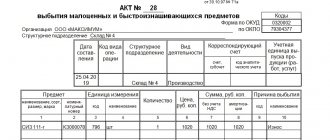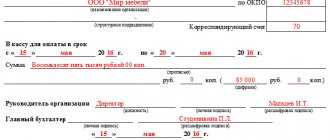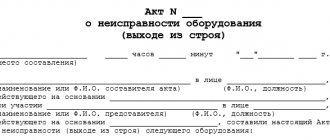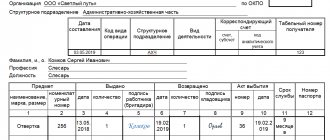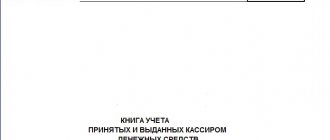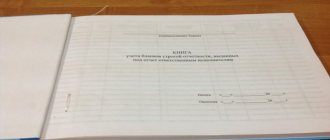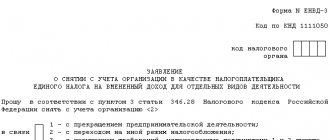This document is intended to formalize the inventory result. It is filled out after the protocols (INV-4, INV-3), as it records discrepancies in the warehouse and actual balances. INV-26 is a kind of final document based on the results of a scheduled or unscheduled inspection. Do not forget that the entire procedure is preceded by INV-22 or an order (instruction) to conduct an inventory.
- Form and sample
- Free download
- Online viewing
- Expert tested
FILES
Before you are going to print out INV-26, please note that this document is displayed on 2 sides of the sheet: on the first there is the form for recording results with a listing of positions, and on the second the signatures of responsible persons from the commission and management of the enterprise are placed, and also wet printing.
How is the document used?
Based on the INV-26 form, a statement is generated that reflects the results of all inventories carried out by the company during the year.
The current version of the corresponding form was introduced into business circulation by Decree of the State Statistics Committee dated March 27, 2000 No. 26. The obligation to enter data on inventories carried out by the organization during the year into a separate document is established by clause 5.6 of Order of the Ministry of Finance of Russia dated June 13, 1995 No. 49.
The statement in question can also be used as a tool for reflecting surpluses and shortages discovered during a separate inventory. Note that the INV-26 form can also be used when conducting both scheduled and unscheduled inventories.
For information about what actions should be taken when identifying deviations from accounting data during an inventory, read the material “Act of Inventory of Fixed Assets - Sample 2020-2021” .
Inventory sheet - sample filling
Organizations, in case of creating their own INV-26 form, can borrow a sample filling from the Goskomstat form. The inventory sheet, drawn up according to all the rules, must contain the following sections:
- accounting accounts;
- information about inventory discrepancies in monetary terms;
- information about the amounts of damaged goods and materials;
- data on misgrading, write-offs and identified losses at the expense of responsible persons (in rubles).
The reliability of accounting is confirmed by the real picture after the inventory. INV-26 reflects the results of all audits carried out during the year and allows us to identify deviations in accounting from real data in full.
The presented inventory list also contains such mandatory details as the name of the enterprise. If the audit was carried out in a separate structural unit, then this information must also be indicated. The data is confirmed by the signatures of the responsible persons, the manager, and members of the inventory commission.
The inventory sheet should contain data not only for each accounting account, but also provide general information about the amounts of identified shortages or surpluses received. Based on the final indicators, it is necessary to adjust the accounting data.
What are the specifics of the structure and filling of the document?
The statement based on the INV-26 form includes information such as:
- the name of the accounting account, the data of which is used to identify surpluses or shortages;
- number of the corresponding account;
- information about detected surpluses or shortages;
- data on damaged property identified during the inventory;
- information on the offset of shortages and damaged property by re-grading;
- information on the write-off of shortages and damaged property within the accepted norms of natural loss of resources (or in excess of the relevant norms);
- information about the attribution of shortages and damaged property to the perpetrators.
Regrading can only be taken into account in accounting. The tax authorities have restrictions and nuances. ConsultantPlus experts explained in detail what exactly and how to correctly display identified surpluses and shortages of similar goods in accounting and tax accounting. Study the material by getting trial demo access to the K+ system.
The document is signed by the director of the company, its chief accountant, as well as the head of the commission that conducts the inventory.
For information on the document defining the composition of the inventory commission and the conditions for conducting the inventory, read the article .
Filling in the fields
In the header (as well as at the beginning of other inventory statements) you must indicate:
- OKPO code,
- organization,
- activity code.
The following remain at the discretion of the filling party: the name and code of the structural unit and the type of operation. The latter is used by enterprises using a coding system.
Although it is customary to draw up such a statement based on the results of the annual audit, the Rosstat decree does not predetermine a specific minimum period for which the form must be filled out. The compilation date may be later than the end date of the inventory.
— option based on the results of an unscheduled audit.
In terms of the content of the fields, INV-26 is similar to other forms-inventory of inventory items, from which you can transfer data on the composition of the commission and responsible persons.
Of course, after verification, not all fields may be filled in. Those that do not provide values are left blank (no dashes are placed here).
Another similarity with INV-3 and INV-4 is that the number of rows in the table can be increased if the need arises. As a rule, this happens due to a large number of discrepancies during the audit at the end of the year.
While everything is clear with column No. 1 , the second column of the form requires explanation. Here you can enter both fixed assets (in our example) and the cash register, as well as raw materials and other inventory items. In column No. 2 we indicate the type; This form of inventory does not require greater detail.
The last line of the document contains the total values for all columns from the fourth to the tenth.
— “Total” for all inventory and write-offs for shortages. Values are not cumulative.
Where is the sample for filling out INV-26
Our experts have prepared for you a statement to reflect the inventory results in the two most popular formats - in the form of a form, as well as a completed sample document.
The form corresponding to the INV-26 form in Word format can be downloaded here.
You can also upload a completed sample document.
Download form INV-26 (excel) for free
Get the form for free!
Register in the online document printing service MoySklad, where you can: completely free of charge:
- Download the form you are interested in in Excel or Word format
- Fill out and print the document online (this is very convenient)
INV-26 is used when conducting both scheduled and unscheduled inspections. A sample form was developed by Goskomstat. The unified form INV-26 is not mandatory. You can design your own form. But keep in mind that the form is complex, so it’s better to take our example of filling out INV-26, it contains all the required details. We have documents in different formats - free INV-26 (word) can be found here.
Please note that it is necessary to check:
- when transferring company property for rent, purchase or sale,
- before preparing annual reports,
- when changing materially responsible persons,
- in case of theft or damage to goods and materials,
- in case of natural disasters, fire, accidents or other emergency situations,
- upon liquidation of an enterprise.
Results
Form INV-26 is a document that can be used both to reflect the results of a single inventory and to record the results of all audits carried out by the company during the year.
One of the main goals of inventory is to identify surpluses or shortages of certain values.
Form INV-26 is one of the most convenient tools for solving this problem, since its structure provides fields for indicating all the key parameters for accounting for surpluses, shortages or damaged property of the company. You can find more complete information on the topic in ConsultantPlus. Free trial access to the system for 2 days.
Carrying out inventory in organizations
In order to confirm the presence of the organization's listed property and check its current condition, an inventory check is necessary. The procedure also allows you to assess the quality of storage of material assets, preventing possible damage to assets. In addition, there are frequent cases of theft and misuse of materials. Some stocks are subject to natural loss - spoilage, shrinkage.
All these factors influence the actual amount of materials and property in the organization. For this reason, accounting data may not coincide with actual balances.
Download the inventory record sheet (form INV-26)
Download sample forms for inventory at the enterprise: INV-1 Inventory listINV-1a Inventory list of intangible assets INV-3 Entering data into the inventory list INV-4 Inventory of shipped ]INV-5 Inventory of goods and materials accepted for storage[/anchor] INV-6 Inventory of goods and materials on the wayINV-15 Inventory of cash availabilityINV-17 Inventory of settlements with buyers and suppliersINV-18 Comparison sheet of inventory resultsINV-19 Comparison sheet of inventory items INV-22 Order for inventory How is the inventory of materials carried out?
INV-26: form and content
When conducting inventories, various forms of inventories, acts and statements are used to draw up the results. Each form has its own purpose and reflects the results of inspections in relation to different types of property and liabilities.
For example:
- INV-1 reflects data on the presence of OS;
- INV-1a – information about intangible assets;
- INV-3 contains data on inventory items;
- INV-4 – information about goods and materials shipped;
- INV-5 – information about inventory items that have been accepted for responsible storage;
- INV-16 – information about securities and BSO.
When discrepancies are established between the actual availability, condition of property and accounting data, comparison statements (INV-18 and INV-19) are drawn up, recording the presence of a shortage or surplus. The INV-18 statement reflects the results of the inventory of fixed assets and intangible assets. The INV-19 statement is intended to reflect data relating to inventory items.
Information about surpluses and shortages is also entered into the record of results identified by the inventory (INV-26), which reflects the results of the inventory carried out for the corresponding reporting period.
A new sample of this form was approved on March 27, 2000 by Resolution of the State Statistics Committee No. 26. Just like other unified forms, from January 1, 2013, this form is not mandatory for use. Business entities have the right to develop, approve and apply their own forms containing all the mandatory details provided for by the accounting law. The list of these details is given in Article 9 of this law and includes the name and date of the document, the name of the business entity, the fact of economic life and its size, full name, position and signatures of the responsible persons.
If the form approved by Goskomstat suits you, then you can INV-26.
form form INV-26
The Goskomstat form contains sections with information:
- about accounting accounts (name and number in accordance with the Chart of Accounts);
- about surpluses and shortages (indicate the amount in rubles);
- about damaged property (indicate the amount in rubles);
- on write-off, re-grading and attribution of losses to responsible persons (indicate the amount in rubles).
Information is reflected both in relation to each individual accounting account (fixed assets, inventory items, intangible assets, financial statements, etc.), as well as the total amounts of identified shortages or surpluses, write-offs, re-grading, etc.
The statement also indicates the name of the organization and the OKPO code. If inventories relate to a specific structural unit, then its name is indicated in the form.
The prepared statement is signed by the organization's officials (manager and chief accountant), as well as the chairman of the inventory commission. The statement is drawn up in 2 copies, one of which is transferred to the accounting department for reporting.
Sample of filling out form INV-26
Form 26.5-1
The patent application consists of five pages:
- title, for reporting identification information about an individual and the validity period;
- name of the type of activity;
- information about the place of business;
- information about vehicles (when choosing to transport goods and passengers);
- information about objects used in business (for leasing premises; retail trade; provision of catering services).
The first two pages are filled out by all applicants, and the pages containing information about transport or about trade and catering facilities are completed only when choosing the appropriate line of business.
The form is in editable PDF format. To fill it out correctly, it is recommended to use Acrobat Reader.
How to simplify your work with documents and keep records easily and effortlessly more>>
Special program for small businesses
Business.Ru - online program for everyone:
- 50 current document forms
- Trade and warehouse accounting
- CRM system for working with clients
- Bank and Cashier
- Integration with online stores
- Built-in mail and SMS sending
- One-click reports

